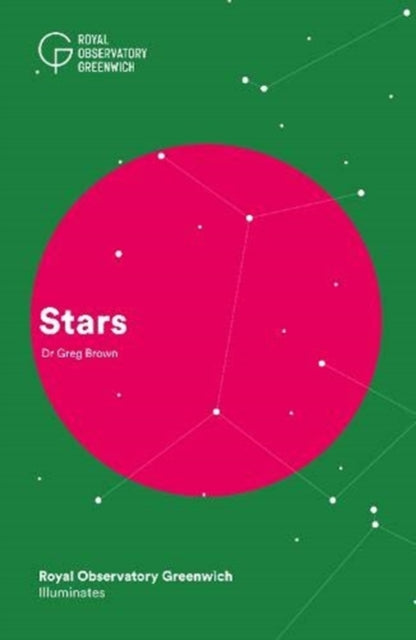Greg Brown,Royal Observatory Greenwich
Stars
Stars
YOU SAVE £2.86
- Condition: Brand new
- UK Delivery times: Usually arrives within 2 - 3 working days
- UK Shipping: Fee starts at £2.39. Subject to product weight & dimension
Bulk ordering. Want 15 or more copies? Get a personalised quote and bigger discounts. Learn more about bulk orders.
Couldn't load pickup availability
- More about Stars
Humans have a fascination with stars, from observing them with the naked eye to using telescopes to explore deep space. In the past, people saw patterns in their random arrangement and invented stories and dot-to-dot puzzles. However, it's only in the last century that we've learned more about the nature of these distant lights, which is more incredible than any legend. Astronomer Dr. Greg Brown of the Royal Observatory Greenwich will explain how stars are born, how long they live, and how many times you can say "trillion" before it starts sounding made up.
Format: Paperback / softback
Length: 120 pages
Publication date: 11 February 2021
Publisher: National Maritime Museum
Stars have captivated humanity for centuries, whether observed with the naked eye or through the most powerful telescopes. Our ancestors saw patterns in their seemingly random arrangement, giving rise to legends and the pastime of dot-to-dot. However, it was only in the last century that we began to unravel the mysteries of these distant lights. What are stars made of? How long do they live? And how many trillions of times can the word trillion be said before it loses its meaning?
Astronomer Dr. Greg Brown of the Royal Observatory Greenwich takes a brief detour from his obsession with black holes to shed light on the lives of stars, culminating in their ultimate fate - black holes. In this fascinating lecture, Dr. Brown delves into the birth, life, and death of stars, exploring the processes that shape their existence and the incredible phenomena that occur in the final stages of their journey.
Stars are born in vast clouds of gas and dust, known as nebulae, which collapse under the force of gravity. The process of star formation can take millions of years, as the nebula's material is heated and compressed by the intense radiation from nearby stars. Once a star is formed, it begins to generate energy through the process of nuclear fusion, which involves the fusion of hydrogen atoms into helium atoms.
The life of a star can vary greatly depending on its mass and composition. Smaller stars, such as our sun, can live for billions of years, while larger stars can live for trillions of years. The lifespan of a star is determined by a variety of factors, including its mass, the rate at which it generates energy, and the amount of matter it consumes through the process of stellar evolution.
As a star ages, it undergoes a series of changes known as stellar evolution. In the early stages of a star's life, it burns hydrogen fuel, generating energy through the process of nuclear fusion. As the hydrogen fuel is depleted, the star transitions to a different stage of its life, known as the red giant phase. In this phase, the star expands and cools, becoming a red giant star. As the star continues to age, it eventually becomes a white dwarf, a dense and compact star that no longer generates energy through fusion.
Eventually, even the most massive stars will exhaust their fuel and collapse under the force of gravity. This collapse is known as a supernova, and it is one of the most spectacular events in the universe. A supernova can release more energy than the sun has produced in its entire lifetime, and it can be observed across the entire electromagnetic spectrum.
The fate of a star ultimately depends on its mass. Stars with masses less than about three times the mass of the sun will become white dwarfs, while stars with masses greater than about three times the mass of the sun will become black holes. Black holes are incredibly dense objects that have a gravitational pull so strong that nothing, not even light, can escape from them.
In conclusion, stars have captivated humanity for centuries, and our understanding of them has continued to evolve. From the birth of stars in nebulae to their final fate as black holes, stars continue to inspire and fascinate us. Whether observed with the naked eye or through the most powerful telescopes, stars remain a testament to the incredible wonders of the universe.
Weight: 122g
Dimension: 176 x 141 x 13 (mm)
ISBN-13: 9781906367817
This item can be found in:
UK and International shipping information
UK and International shipping information
UK Delivery and returns information:
- Delivery within 2 - 3 days when ordering in the UK.
- Shipping fee for UK customers from £2.39. Fully tracked shipping service available.
- Returns policy: Return within 30 days of receipt for full refund.
International deliveries:
Shulph Ink now ships to Australia, Belgium, Canada, France, Germany, Ireland, Italy, India, Luxembourg Saudi Arabia, Singapore, Spain, Netherlands, New Zealand, United Arab Emirates, United States of America.
- Delivery times: within 5 - 10 days for international orders.
- Shipping fee: charges vary for overseas orders. Only tracked services are available for most international orders. Some countries have untracked shipping options.
- Customs charges: If ordering to addresses outside the United Kingdom, you may or may not incur additional customs and duties fees during local delivery.


